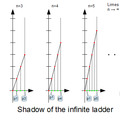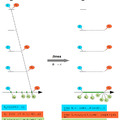!!! In January 2025, I made significant discoveries and changes to my theory, so not all of the statements described here are true. I have only left my previous articles to illustrate the development of my thinking. !!!
The rational numbers is determined as quotient of integers. The integers are derived from the natural numbers, added to the series of natural numbers, negative whole numbers series. No accident that I use the concept of the series instead of the set concept. Because the natural numbers it is only as a series can be defined and managed. This is to be understood that defined one first member of the series, and is defined the successor operations, which defines only one next member of each member of series. This defines implicitly the infinitude of the sequence, which is called countably infinite. The name is motivated that the successor operations can be described as a counting operation. This definition of the topological description of the natural numbers, to which of course must be added to the definitions of the basic operations of the natural numbers and the definitions of representations of numbers, but we do not deal with this now. The series of natural numbers is defines a base series, N = (0,1,2,3, ..) that is used to define any other series with an arbitrary function. So any mathematical object that can be assigned to the series of natural numbers, is itself a series, and each series up to countably infinite cardinality. The series of integers is countable, since the positive and negative alternately assigned to the series of natural numbers, Z = (0.1, -1.2, -2.3, -3.4, -4, ...). The rational numbers determined by the quotient an integer, and a non-zero natural number, and also countable. Cartesian product of integers, and the non-zero natural numbers forming a half plane, and walk through according to spiral around the origin.
Q = (d(0,1),
d(1,1), d(0,2), d(-1,1),
d(2,1), d(1,2), d(0,3), d(-1,2), d(-2,1),
d(3,1), d(2,2), d(1,3), d(0,4), d(-1,3), d(-2,2), d (-3,1),
d(4,1), d(3,2), d(2,3), d(1,4), d(0,5), d(-1,4), d(-2,3), d(-3,2), d(-4,1), ...),
where d(a,b) = a / b,
and the sum of absolute values of the coordinates monotonically increasing in the series.
Who have met during their studies with definitions of N, Z, and Q, their obviously have notice that I have not used the usual definition like sets, even I deliberately avoided this and the following also I will show why I did.
The rational numbers can not represent all points of real line, such as the square root of two, or the unit circle circumference can not be written in the quotient of two integers. Therefore, are needed to be introduced the real numbers that the whole real line is continuously covered.The real numbers we define a limit training of rational numbers series, in other words, any real number arbitrarily small positive railing more approachable with a rational series.
Next, construct the [0,1] real interval as a set. Take the set of n-digit decimal fractions in this interval, Q10 [0,1] (n) and form a series of them, Q10 [0,1] = (Q10 [0,1] (1), Q10 [0,1] ( 2), Q10 [0.1] (3), ...). The series consists of all the finite decimal fraction in [0,1] interval so containing any rational number that can be represented by a finite decimal fractions. But do not include the irrational numbers, and except of sequences of rational numbers closing with infinite 9-digit, do not include any rational numbers that can only be described as an infinite decimal fraction (eg 1/3). Now let's take this to the limit of the sequence of set. The series of sets limits are also set, and will contain all rational numbers and all limit of all serial of rational numbers in the interval [0,1], ie, the limit set is none other than the [0,1] real interval. So limes(n = 1...∞) Q10 [0,1] (n) = R [0,1]
Then, ask the question, what is meant by the set of all rational numbers. Narrow down the question to the interval [0,1]. The answer, unfortunately, the same set of limits of series claims to the real interval defined above. In other words, in order that all the [0,1] interval in a bounding set of rational numbers, we must take the limit of that range, otherwise we can not claim that every rational number is included in a set.
No other mathematical process which generates all members of a series such the limit training. Whoever claims opposite this, only prisoner of his own confused ideas, but no argument or mathematical definition to show proof his ideas. It is clear is that those who the Cantor's diagonal traversal method on infinite decimal fraction deemed suitable for proof the larger cardinality the power set them just assume that the definition of infinite decimal fraction involving the limit of training is analogous to the infinite set of each member of a countable series, even if in other cases it can try to deny it. But the math does not tolerate such licentiousness. These confusing ideas source is very easy to grasp, namely the erroneous notion that a series can be treated as a set. It is not true. But with this false statement rammed to us the foundations of mathematics has been for 120 years. Can be read the causes, consequences, and corrections of these erroneous ideas in my earlier articles. However I draw attention to if recite my claim from my article by young student on exam then chances are cut from the exam, today, as the mathematicians believe in, rather than thinking.
And so the function Dirichlet wich interpreted on real numbers, and defined as zero on rational locations and one on irrational places, reality everywhere zero, since all rational numbers obtained with limits training, which corresponds to the set of real numbers.
Budapest, 10 september 2012 Takács Ferenc bp.




